Yesterday I did a quick course in the basic use of the Austrian
scythe. These are my notes and recollections. Do not mistake them for
an actual scything course! Images follow:
cc-by-sa on
everything.
The course was taught by
Clive Leeke, who explained that
the traditional (heavy) English scythe had mostly in fact been used by
itinerant Irish farm workers, and had pretty much fallen out of use in
the 1890s with the advent of the horse-drawn mower. The
Austrian scythe
saw some popularity in this country with the self-sufficiency movement
in the 1970s, but really came into its own more recently as the
favoured tool of anti-GM crop protesters and has taken off from there.
The Eastern European style is still seen as far west as Poland, and is
rather simpler than the Austrian, but also less adjustable.
The wooden bit is the snath (probably derived from a German or
Anglo-Saxon word for "branch", which it originally was). The end of
the tang of the blade slips into a hole in this, and the tang is held
to the snath with a retaining bracket and two Allen-keyed screws.
(Care is needed with removing, as you can easily find you push your
fingers into the blade.)
Blades come in various thicknesses (lawn, standard/grass, ditch,
brush); a thinner blade is also flatter and straighter. A heavy blade
can get through thicker vegetation, but is more likely to bend rather
than cut the thinner stuff. The blade is curved in three dimensions,
and (if it's any good at all) is hand-made, usually in Austria. Big
competition blades go up to 160cm, but we were using 60cm blades and
it was recommended that we buy no more than 75cm.
A Size 2 snath is for people 4'6" up to about 5'6"; size 3 goes up to
about 6'4". When setting up the snath, put the blade end on the
ground, and set the first handle so that it's at or slightly above the
height of the greater trochanter (the exposed "crest" of the femur).
Once that's done, the second handle should be slightly more than a
cubit from the first (i.e. you should just barely not be able to touch
it when resting your elbow on the first handle). You can set this
further away for a larger arc (but less power).
The blade should be attached loosely, then set at the preferred angle.
One can go into an awful lot of detail about this, but the easiest
version is to have it more or less centred within its retaining
bracket. A more "open" blade (more obtuse angle to snath) gives you a
wider but weaker cutting area, while a more "closed" one gives you a
narrower but stronger one. Particularly if the blade is fully open,
the snath can snap if the blade's stopped suddenly, for example by an
anthill. The Allen-keyed nut can work loose over time, so watch out
for that.
Although the blurb for the course had recommended steel-toed boots,
and I was wearing them, most scythers apparently prefer lighter-weight
footwear such as sandals, or go completely barefoot, to be more aware
of the ground conditions. Being fair, the blade didn't come anywhere
near my feet during the day.
When one's using the scythe, one doesn't hover it over the grass: one
rests it on the ground, even with a slight downward pressure. The
contact point along the curved blade should be roughly a quarter to a
third of the way along its length for a simple lawn, but this varies a
lot, and one has to adjust it to the lie of the grass. (Vertical grass
is best; if it's lying down, it should be pointing away from one.) The
blade should be making contact with the ground at the far (blunt)
edge, with the cutting edge tilted slightly upwards towards one; this
way it can get under flattened grass. (Too high and it skates over
grass clumps; too low and you dig into the ground.)
Grass is best cut when wet: immediately after rain, for example, or
within a couple of hours of dawn when it still retains water from the
night.
One has to re-sharpen an Austrian scythe blade quite often. This is
done with the blade edge down, rib pointing away from one, from the
far side: the wet stone fits to rib and edge to give the right angle.
One strokes diagonally to the right and a little downwards, pulling
quite hard, aiming to cover the whole blade in about five strokes.
Four or so of these sequences should be enough. One then runs the
stone horizontally along the lower face of the edge (the side towards
one) to flatten any burrs that have appeared. (American-style blades
don't need as much sharpening, but they're vastly heavier.)
Through the course of the stroke the load should be even between left
and right arms (and ditto the legs). The left arm should be straight
at the end of the stroke, keeping the blade pressed to the ground. In
light grass, a 180° stroke is the ideal, but in thicker vegetation,
one can drop this to 90° or so. As in most things, keep the back
straight and don't stoop, but bend the knees as needed. If one's
getting cunning about it, one uses the whole of one's leg and torso
strength, and exhales on the stroke, very much like a slow version of
a proper punch in any of the martial arts. (Apparently there's an
Austrian course in Tai Chi plus scything.)
The blade ends up meeting the grass at a fairly shallow angle; one
might only cover a few inches front-to-back per stroke, even though
the blade's moving much further. This helps it to slice through
vegetation rather than knock it down as it would if it came at the
stalks straight-on.
The cut grass ("risings") should be raked and removed rather than left
in the meadow, apparently; it's good for spreading under fruit trees
or as animal fodder, but if left behind it can produce too much soil
nutrition and encourage weeds. If one's shifting the cut grass about,
the scythe works surprisingly well for gathering and rolling a bundle
of loose vegetation.
The cleared area is the swath; the small pile of cut grass is the
windrow (because if left it will be dried to hay by the wind).
While one can sharpen a blade more or less indefinitely, it's best if
it's peened once in a while (Clive recommended once per two acres or
so, so that'll be once in a hundred or more cuttings of my meadow at
home.) Apparently "Welsh Phil" is the master of this art: there's
competitive peening even more than there is competitive scything. And
it's much louder. One can get fancy with a table anvil, but a basic
peening jig with a couple of dollies (movable parts with the bottom
carefully shaped) is perfectly adequate. The blade must be flat to the
jig, and hammering should be as consistent as possible; the metal will
be cold-flowed into the gaps. (And then file both sides to get rid of
the inevitable burrs.)
If mowing on a slope, move across the slope keeping the downhill side
on your left (and probably put the handle a bit closer to the blade
than usual).
When ending the session, scrub the blade with cut grass, and
particularly make sure the Allen screw heads haven't got clogged up.
Over winter, grease or WD40 the blade.
Because of the vast popularity of the things (Simon at
The Scythe Shop has seen
his sales triple this year), Clive wasn't able to sell us scythes;
he's out of stock. But I hope to have one soon.
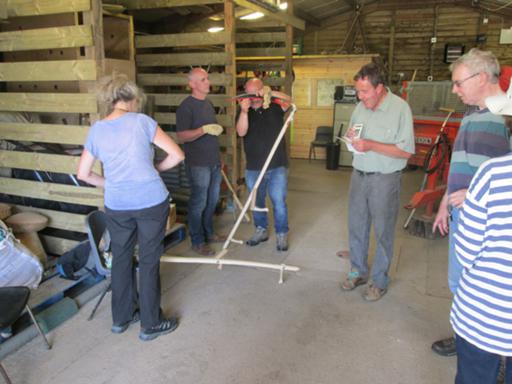
Inspecting the Austrian scythe. (Michael and Phil, the owners of the
Two Cocks Brewery, were among those
attending the course. Most of the people there had an acre or two of
woodland or meadow which they wanted to keep up without power tools.)
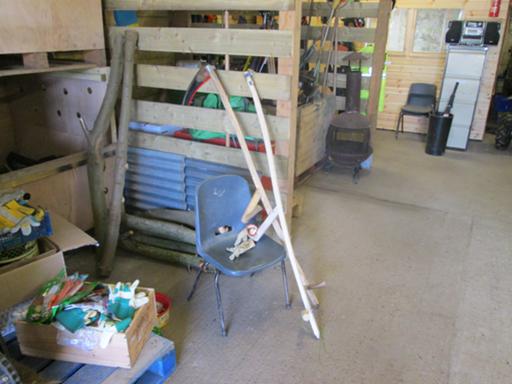
Austrian scythes.
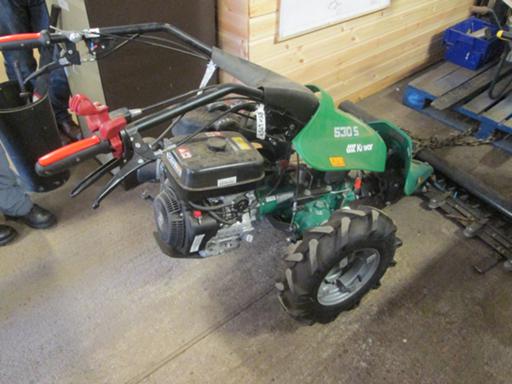
The Competition. It does get more area mown in a day, but it's louder,
harder work to operate, vastly more expensive, and much less fun.
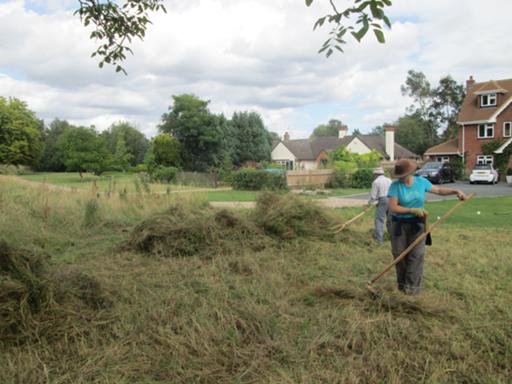
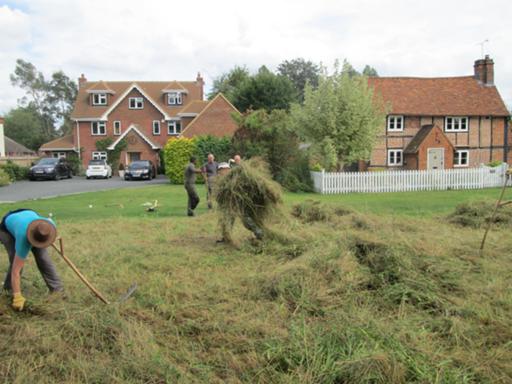
The haymakers.
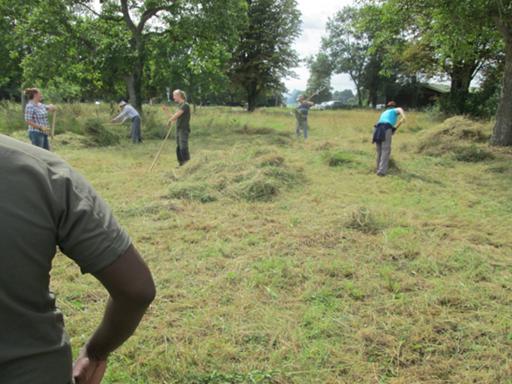
Ten of us novices cleared all this, and probably twice as much again,
in just an hour's work.
I was a little tired and a little stiff, but I definitely want a
scythe of my own now.
Comments on this post are now closed. If you have particular grounds for adding a late comment, comment on a more recent post quoting the URL of this one.